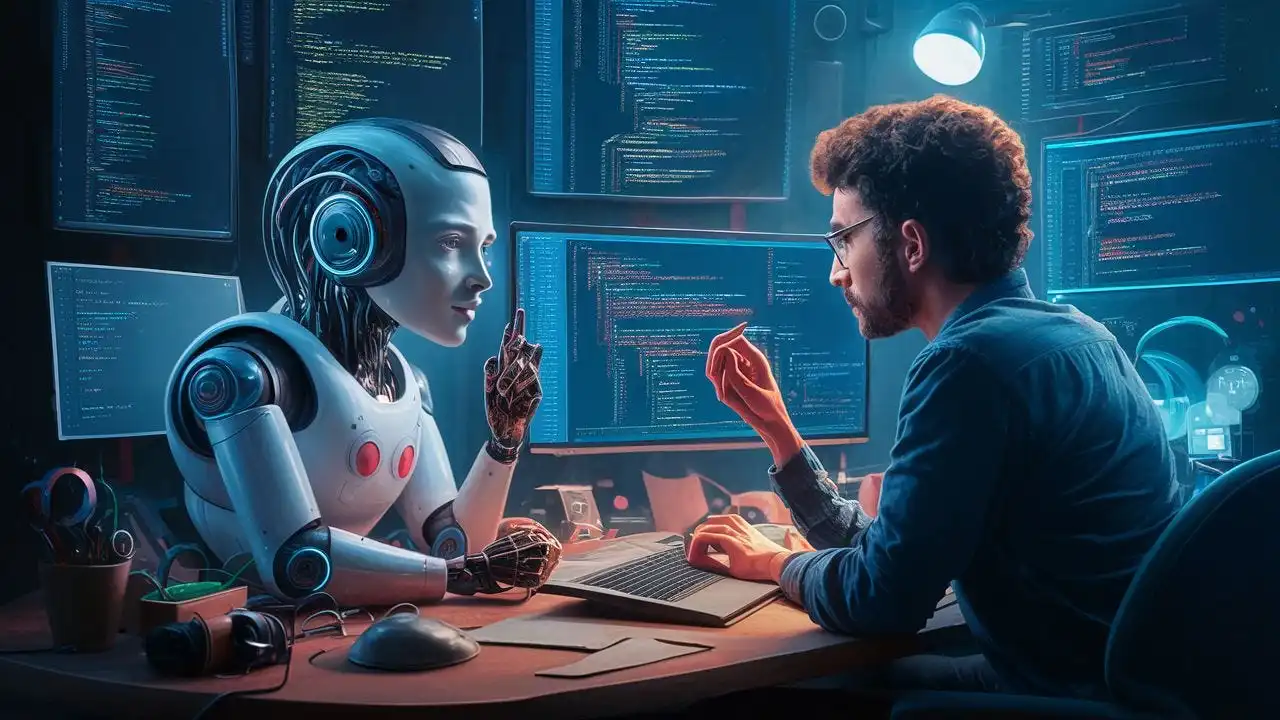The AI Revolution: A Software Engineer's Guide to Thriving with Generative AI
Discover how generative AI is reshaping software engineering and learn to thrive in this new era. Explore the opportunities, challenges, and essential skills for developers in the age of AI-augmented development.

In the ever-evolving landscape of technology, we software engineers have always prided ourselves on being at the forefront of innovation. We’re the architects of the digital world, constantly pushing the boundaries of what’s possible. But now, we find ourselves on the cusp of a transformation so profound that it’s reshaping not just our industry, but the very nature of intellectual work itself. I’m talking, of course, about the rise of generative AI.
For decades, our relationship with computers has been one of master and tool. We’ve meticulously crafted instructions, line by line, telling these powerful yet fundamentally simple machines exactly what to do. But something extraordinary is happening. The lines between human and machine intelligence are blurring, and we’re witnessing the birth of systems that can learn, think, and create in ways that eerily mimic our own cognitive processes.
At the heart of this revolution are large language models (LLMs) like GPT-4. These aren’t just sophisticated pattern-matching algorithms; they represent a fundamental leap forward in artificial intelligence. Trained on vast swathes of human knowledge, these models have developed an uncanny ability to understand and generate human language, write code, solve complex problems, and even engage in creative tasks that we once thought were the exclusive domain of human intelligence.
The implications of this shift are staggering. Imagine having a brilliant colleague who never sleeps, never gets tired, and can instantly recall every piece of information they’ve ever encountered. That’s essentially what these AI models represent. They can assist us in debugging complex code, suggest optimizations, and even architect entire systems. They can explain intricate programming concepts with the patience of a seasoned mentor, or brainstorm solutions to problems with the creativity of a seasoned innovator.
But here’s where it gets really interesting: unlike traditional software that we craft line by line, these AI models emerge from a process more akin to how humans learn. They’re not explicitly programmed with rules and logic; instead, they’re trained on massive datasets, discovering patterns and forming connections in ways that can surprise even their creators. This fundamentally changes the game for us as software engineers.
So, what does this mean for our profession? Are we coding ourselves out of a job? The short answer is no, but the longer answer is more nuanced and, I believe, far more exciting.
First and foremost, we need to shift our perspective. Rather than viewing AI as a threat, we should see it as a powerful tool that can amplify our capabilities. Think of it as pair programming taken to the extreme. With AI assistance, we can tackle more complex problems, explore more innovative solutions, and work at a pace that would have been unthinkable just a few years ago.
Let’s consider how this might play out in practice. Say you’re tasked with building a new feature for a large-scale web application. In the past, you might have spent hours or even days researching best practices, writing boilerplate code, and debugging simple syntax errors. Now, you can leverage AI to handle much of this grunt work. You can ask the AI to generate a basic implementation, explain the rationale behind certain design choices, or even explore alternative approaches.
But here’s the crucial point: the AI isn’t replacing your role; it’s augmenting it. You’re still the one making the high-level design decisions. You’re still the one who understands the broader context of the project, the specific needs of your users, and the intricate details of your existing system architecture. The AI is a powerful assistant, but you’re the one steering the ship.
This shift allows us to focus more of our energy on the aspects of software engineering that truly require human creativity and insight. Instead of getting bogged down in the minutiae of syntax and boilerplate, we can spend more time on system architecture, user experience design, and solving the novel, complex problems that arise in large-scale software development.
Moreover, AI is dramatically accelerating the pace of development. With AI assistance, we can move from idea to working prototype faster than ever before. This rapid iteration allows for more experimentation and potentially leads to more innovative solutions. We can quickly test out different approaches, get immediate feedback, and refine our designs in real-time.
But to truly harness the power of AI in our work, we need to develop a new skill set. Perhaps the most crucial of these is what’s known as “prompt engineering” or “prompt design.” Just as we’ve always needed to know how to communicate effectively with computers through code, now we need to master the art of communicating with AI models through prompts.
Prompt engineering is about crafting clear, effective instructions that guide the AI towards the desired output. It’s a subtle art that combines elements of clear communication, system design, and even a bit of psychology. A well-crafted prompt can mean the difference between a vague, unhelpful response and a precise, insightful solution.
For example, instead of simply asking an AI, “How do I implement a sorting algorithm?”, a skilled prompt engineer might say, “Explain the implementation of a quick sort algorithm in Python, focusing on its time complexity and how it compares to other sorting algorithms for large datasets.” The more specific and contextual your prompt, the more valuable the AI’s response will be.
Developing this skill requires practice and a willingness to experiment. It involves learning how to provide the right amount of context, how to break complex problems into manageable chunks, and how to iteratively refine your queries to get the best results. In many ways, it’s not unlike the process of learning to write good code – it takes time, effort, and a lot of trial and error.
As we integrate AI more deeply into our workflow, we also need to be mindful of its limitations. While these models are incredibly powerful, they’re not infallible. They can make mistakes, exhibit biases present in their training data, or sometimes generate plausible-sounding but incorrect information (a phenomenon often referred to as “hallucination”).
This means that as software engineers, we need to develop a keen sense of when to trust AI-generated output and when to double-check or rely on our own expertise. We need to be critical thinkers, always ready to verify and validate. In a sense, we’re becoming not just programmers, but also curators and validators of AI-generated content.
This new paradigm also raises important ethical considerations. As we build systems that increasingly rely on AI, we need to be acutely aware of issues like data privacy, algorithmic bias, and the potential societal impacts of the technology we’re creating. We have a responsibility to ensure that the AI-powered systems we build are fair, transparent, and beneficial to society as a whole.
For instance, if we’re using AI to assist in hiring decisions or to generate content for a wide audience, we need to be vigilant about potential biases in the model’s outputs. We need to design systems with checks and balances, and always keep the human element in the loop for critical decisions.
Despite these challenges, the potential of AI in software engineering is truly exciting. We’re entering an era where we can build more complex, more powerful systems than ever before. We can tackle problems that were once thought to be computationally intractable. We can create more intuitive, more responsive user experiences. In short, we can push the boundaries of what’s possible in ways that were once the stuff of science fiction.
But to fully realize this potential, we need to commit ourselves to continuous learning and adaptation. The field of AI is evolving at a breakneck pace, with new models, techniques, and tools emerging seemingly every day. As software engineers, we need to stay informed about these developments and be ready to incorporate them into our work.
This might mean dedicating time each week to experimenting with new AI tools, attending workshops or conferences on AI in software development, or even contributing to open-source AI projects. The goal is to not just keep up with the changes, but to be at the forefront, helping to shape the future of our field.
As AI takes on more of the routine aspects of coding, our value as software engineers will increasingly lie in our ability to see the big picture. We need to strengthen our skills in areas like systems thinking, architecture design, and understanding business and user needs. We need to be able to design robust, scalable systems that effectively integrate AI capabilities.
Moreover, our “human” skills become more crucial than ever. Empathy, creativity, critical thinking, and effective communication are attributes that AI still struggles to replicate. Our ability to understand the nuanced needs of users, to collaborate effectively with team members, and to navigate the complex ethical landscape of technology development – these are the skills that will set us apart in the AI-augmented future of software engineering.
In conclusion, we’re standing at the threshold of a new era in our field. The integration of AI into our workflow isn’t just changing how we code – it’s redefining what it means to be a software engineer. It’s opening up new possibilities, new challenges, and new frontiers for innovation.
This transition might seem daunting, but I believe it’s an incredibly exciting time to be a software engineer. We have the opportunity to be at the forefront of a technological revolution, to shape the future of not just our industry, but of society as a whole.
So, fellow developers, let’s embrace this change. Let’s dive into the world of AI with curiosity and enthusiasm. Let’s explore its potential, push its boundaries, and use it to build amazing things. The future of software engineering is AI-augmented, and it’s going to be an exhilarating journey.
Are you ready to level up? The AI revolution is here, and it’s time for us to lead the charge. Let’s step into this brave new world and show what human creativity, augmented by artificial intelligence, can really achieve. The possibilities are limitless, and the future is ours to create.
